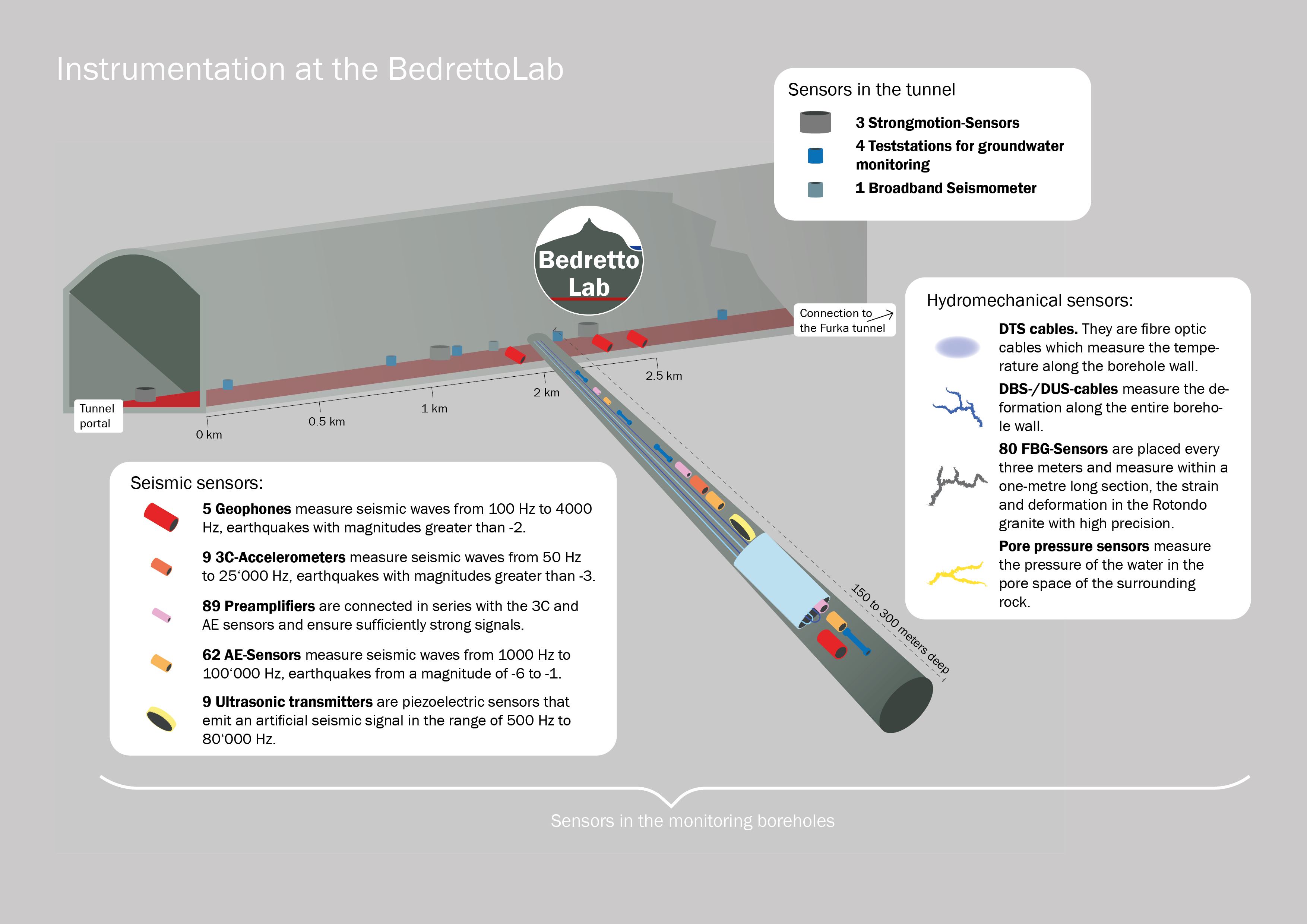Earthquake Monitoring
Gain a better understanding of earthquakes process
Understanding earthquakes, natural ones as well as induced ones, is a key objective of the BedrettoLab. How do earthquakes start, how do they propagate along a fault and why do they stop are fundamental research questions that can be studied safely in the BedrettoLab. Likewise, we can explore how we can use and control millions of tiny micro-earthquakes to engineer an effective fracture network needed for an underground heat exchanger, a so-called Enhanced Geothermal System (EGS), without causing earthquakes that are felt or even damaging.
To study the physics and the geo-mechanics of earthquakes in realistic conditions at the BedrettoLab, we conduct injection experiments and intentionally trigger very small earthquakes that we observe with numerous sensors from close by. For this purpose, a dense and reliable seismic monitoring system must be in operation. We intend the largest of these earthquakes to be over a thousand times smaller (in their amplitude and energy) than an earthquake that might be felt by a person, e.g., in the Bedretto valley. Earthquakes are typically felt at the surface when they reach a magnitude of 2.5 or higher, damaging earthquakes have typically a magnitude 5 or larger.
Minimizing the risk
To minimize the seismic risk from our experiments, we conduct comprehensive probabilistic seismic hazard and risk studies before starting any experimental work, and we follow strict risk mitigation protocols. These studies show that the main risk is to the tunnel and the people in the tunnel because they are much closer to the hypocenter of the quakes.
To mitigate the risk, it is critically important to monitor earthquakes in real-time in the lab during an experiment, but also before and after. If during an injection a predefined magnitude or ground shaking threshold at the tunnel wall were to be exceeded, the so-called traffic light protocols define if an experiment must be paused or stopped. The thresholds are set such that the risk of slight damage to the tunnel wall is less than 0.1 percent in an experiment. The risk assessment and risk mitigation procedures are designed following also the good practice guidelines that the Swiss Seismological Service at ETH Zurich has proposed for deep geothermal projects within the GEOBEST project framework.
Continuous seismic monitoring at the BedrettoLab
To monitor the seismicity around the clock, the national seismic monitoring network operated by the Swiss Seismological Service at ETH Zurich has been densified with additional seismic stations in the surroundings of the BedrettoLab as well as within the tunnel and in selected boreholes. This allows to reliably monitor and register all earthquakes of potential relevance for the safety of the wider Bedretto area, and for the BedrettoLab itself. All earthquakes these stations detect, natural and induced events, are published in the openly accessible earthquake list.
The improved monitoring not only allows us to detect the earthquakes we induce, but also to detect events of magnitude up to zero that are taking place about 1 kilometer from the lab, and are likely natural, possibly triggered by strong rain fall.
Seismometers of the National Network near Bedretto
Sensors of the Bedretto Reservoir Project Monitoring Network
In the framework of the Bedretto Reservoir Project a medium scale reservoir is created. This means that two boreholes will be connected by fractures to allow water circulation from one borehole to the other. In order to observe the processes during fracture generation and water circulation in detail, the rock volume is monitored using a variety of instruments. Several sensors were newly developed under the lead of Dr. Katrin Plenkers to meet the harsh conditions in the Bedretto laboratory. In summer 2020 and 2021 an expert team has installed the monitoring system in the monitoring boreholes of 101 meters to 300 meters length.

